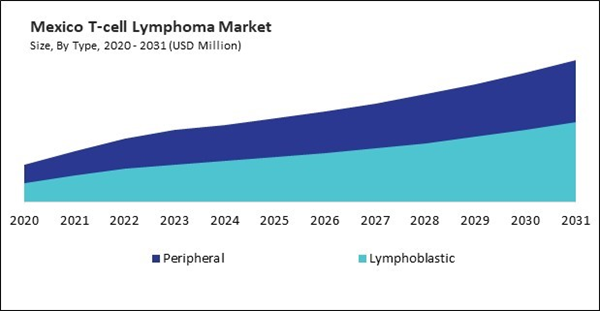The US market dominated the North America T-cell Lymphoma Market by Country in 2023, and would continue to be a dominant market till 2031; thereby, achieving a market value of $980.1 million by 2031. The Canada market is experiencing a CAGR of 10% during (2024 - 2031). Additionally, The Mexico market would exhibit a CAGR of 9.4% during (2024 - 2031).
These lymphomas encompass diverse hematologic malignancies arising from mature T-cells or natural killer (NK) cells, each with unique clinical presentations and challenges. Understanding their applications in clinical practice involves recognizing their diagnostic complexities, treatment strategies, and ongoing research advancements. Diagnosing these lymphomas presents several challenges due to their rarity and diverse clinical manifestations. Initial diagnosis often relies on histopathological examination of tissue biopsies, which helps identify characteristic features of these lymphomas, such as abnormal lymphoid proliferation and tissue infiltration.
Immunohistochemistry and flow cytometry are essential for immunophenotyping, distinguishing T-cell and B-cell lymphomas, and subclassifying T-cell subtypes based on surface markers (CD3, CD4, CD8, etc.). Molecular testing, including polymerase chain reaction (PCR) assays and next-generation sequencing (NGS), aids in detecting genetic abnormalities (e.g., T-cell receptor gene rearrangements) and identifying potential therapeutic targets.
With greater healthcare funding, Canada can invest in state-of-the-art diagnostic technologies essential for early detection and accurate diagnosis of these lymphomas. This includes expanding access to PET-CT scans, molecular testing, and genetic profiling, which are crucial for precise staging and treatment planning. According to the Government of Canada, a total investment of $196.1 billion over ten years was announced, with $46.2 billion earmarked as new funding for provinces and territories to enhance healthcare services for Canadians. Additionally, a $2.5 billion allocation over the same period will support Indigenous priorities and complementary federal support, resulting in a combined investment of $198.6 billion over the decade. Increased healthcare budget allows for the expansion of specialized oncology care facilities and services across Canada. This includes the development of comprehensive cancer centers equipped to provide multidisciplinary care for these lymphomas, integrating medical oncology, radiation oncology, and supportive care under one roof. Thus, rising cancer cases and the healthcare sector in North America is driving the growth of the market.
Based on Type, the market is segmented into Peripheral (Cutaneous T-cell Lymphoma, Anaplastic Large Cell Lymphoma, Angio-immuno-blastic T-cell Lymphoma, and Others) and Lymphoblastic. Based on Therapy, the market is segmented into Chemotherapy, Radiotherapy, Immunotherapy, Stem Cell Transplantation, and Others. Based on countries, the market is segmented into U.S., Mexico, Canada, and Rest of North America.
List of Key Companies Profiled
- Bristol Myers Squibb Company
- Daiichi Sankyo Company, Limited
- Eisai Co., Ltd
- Acrotech Biopharma Inc. (Aurobindo Pharma USA)
- Shenzhen Chipscreen Biosciences Co., Ltd.
- Citius Pharmaceuticals, Inc.
- Genor Biopharma Co. Ltd.
- Innate Pharma SA
- Dizal Pharmaceutical Co. Ltd.
Market Report Segmentation
By Type- Peripheral
- Cutaneous T-cell Lymphoma
- Anaplastic Large Cell Lymphoma
- Angio-immuno-blastic T-cell Lymphoma
- Others
- Lymphoblastic
- Chemotherapy
- Radiotherapy
- Immunotherapy
- Stem Cell Transplantation
- Others
- US
- Canada
- Mexico
- Rest of North America
Table of Contents
Companies Mentioned
- Bristol Myers Squibb Company
- Daiichi Sankyo Company, Limited
- Eisai Co., Ltd
- Acrotech Biopharma Inc. (Aurobindo Pharma USA)
- Shenzhen Chipscreen Biosciences Co., Ltd.
- Citius Pharmaceuticals, Inc.
- Genor Biopharma Co. Ltd.
- Innate Pharma SA
- Dizal Pharmaceutical Co. Ltd.
Methodology

LOADING...









